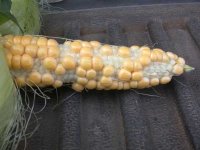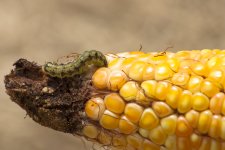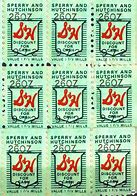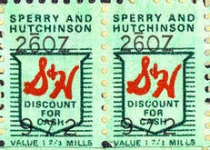I've driven that TP From the western most point to the eastern most point at least a hundred times and and all I could see was field and farms of corn. Never saw so much in my life. Great cash crop.
OT: Hey any Farmers on the board? I drove the PA TP yesterday Pitt to Phila and never seen so much corn.
- Thread starter Mr. Potter
- Start date
You are using an out of date browser. It may not display this or other websites correctly.
You should upgrade or use an alternative browser.
You should upgrade or use an alternative browser.
I'd love to have a few ears of that sweet sweet late summer corn you get on the way from OCMD to HB. So good.
If there has been an increase in the acreage committed to growing corn in this area, it is probably to serve the corn-to-ethanol market that was artificially created by Washington, DC.
?Hey any Farmers on the board? I drove the
THE GREENSTAMP??PA TPyesterday Pitt to Phila and never seen so much corn.
View attachment 381593
That's great and I see a lot around here, Northern Harford county MD, but then explain why a half doz, at the farm stand is, $6.95I've driven that TP From the western most point to the eastern most point at least a hundred times and and all I could see was field and farms of corn. Never saw so much in my life. Great cash crop.
It used to be that you would stop at a “farm stand” and expect to find deals, as you were buying direct and cutting out the middle men.That's great and I see a lot around here, Northern Harford county MD, but then explain why a half doz, at the farm stand is, $6.95

Modern marketing techniques have now turned it around with the “fresh local” and ”farm to table” indoctrination such that we should be grateful for the opportunity to buy from them at any price.
The big city Farmers Markets are now akin to shopping Whole Foods.
No Thanks!
Took a while to sink in but I remember my dad and uncles referring to it in this manner. I believe this was because the TP sign/logo was similar tot he S&H GreenStamps which were a big thing back in the day?? Please correct me if I am wrong.Hey any Farmers on the board? I drove the
THE GREENSTAMP??PA TPyesterday Pitt to Phila and never seen so much corn.
View attachment 381593
For those in the Pittsburgh area, particularly the North Hills, Shenot Farms has the best corn I've ever tasted. They're really fussy about it too, there's no peeling back the husks and taking a look at Shenots, they don't put up with anything that will dry out their product. And you don't need to look at them anyway, they're all good. I've never gotten a bad ear there.
They also tell you the names of the varieties they have at any given time. I had some amazing "Cuppa Joe" last week. Most of the others have stripper names. "Allure." "Essence." "Illusion." "Providence." "Bodacious." I'm not making these up. I always feel like I should be tucking a dollar bill into their husks whenever I go there.
They also tell you the names of the varieties they have at any given time. I had some amazing "Cuppa Joe" last week. Most of the others have stripper names. "Allure." "Essence." "Illusion." "Providence." "Bodacious." I'm not making these up. I always feel like I should be tucking a dollar bill into their husks whenever I go there.
What he's seeing in those huge fields of corn isn't sweet corn. I was raised with my farming family calling it cow corn.It used to be that you would stop at a “farm stand” and expect to find deals, as you were buying direct and cutting out the middle men.
Modern marketing techniques have now turned it around with the “fresh local” and ”farm to table” indoctrination such that we should be grateful for the opportunity to buy from them at any price.
The big city Farmers Markets are now akin to shopping Whole Foods.
No Thanks!
----‐-------------------------------------------------------
"Field corn
Article Talk
Language
Download PDF
Watch
Edit
Field corn, also known as cow corn, is a North American term for maize (Zea mays) grown for livestock fodder (silage and meal), ethanol, cereal, and processed food products. The principal field corn varieties are dent corn, flint corn, flour corn (also known as soft corn) which includes blue corn (Zea mays amylacea),[1] and waxy corn.[2]
Field corn is primarily grown for livestock feed and ethanol production is allowed to mature fully before being shelled off the cob and being stored in silos, pits, bins, or grain "flats". Field corn can also be harvested as high-moisture corn, shelled off the cob and piled and packed like silage for fermentation; or the entire plant may be chopped while still very high in moisture, with the resulting silage either loaded and packed in plastic bags, piled and packed in pits, or blown into and stored in vertical silos.
People may pick ears of field corn when its sugar content has peaked and cook it on the cob or eat it raw. Ears of field corn picked and consumed in this manner are commonly called sweet corn, or "roasting ears" due to the most commonly used method of cooking them."
--------------------------------------------------------------
I'd guess that 99% of the gigantic cornfields people see in the northeast are field corn. Sweet corn fields are usually much smaller as they have to be harvested at a few days notice or the product will become unsellable because it just about turns into shoe leather before it rots. Field corn hardens and has a longer window as to when it can be harvested, although it has to be the correct moisture content %.
Our farm actually used to plant 30 or so different varieties of sweet corn for Penn State Extention when I was growing up. Each year they would experiment with different varieties. Looking back, that was pretty cool.

Sweet Corn Production
Initial investment is relatively low, and many field operations - such as land preparation, planting, and harvesting - can be custom-hired.
On another note, we sold a crap ton of NK-199 back in the day. That was before the genetically altered super sweet corn was introduced.

Home - American Seed Co.
Specializing in Quality Seeds at Affordable Prices Quick Links American Seed is a full line, American owned and operated, seed company located in Spring Grove, Pennsylvania specializing in quality seed at affordable prices. We supply golf courses, landscapers, contractors, stores, farmers...
americanseedco.com
I know here in NEPA farmers lost entire fields of corn because the super dry weather didn't allow for germination. Not sure about your area though.That's great and I see a lot around here, Northern Harford county MD, but then explain why a half doz, at the farm stand is, $6.95

Finally someone here who knows what they’re talking about. We did the same on our family farm growing up. you are correct in that 99% of what these drivers see is field corn raised for animal consumption. Some of it may go into ethanol production for fuel but with all the dairy farms along the turnpike, I’d assume that it’ll be chopped for corn silage and stored in silos or something and fed throughout the winter.What he's seeing in those huge fields of corn isn't sweet corn. I was raised with my farming family calling it cow corn.
----‐-------------------------------------------------------
"Field corn
Article Talk
Language
Download PDF
Watch
Edit
Field corn, also known as cow corn, is a North American term for maize (Zea mays) grown for livestock fodder (silage and meal), ethanol, cereal, and processed food products. The principal field corn varieties are dent corn, flint corn, flour corn (also known as soft corn) which includes blue corn (Zea mays amylacea),[1] and waxy corn.[2]
Field corn is primarily grown for livestock feed and ethanol production is allowed to mature fully before being shelled off the cob and being stored in silos, pits, bins, or grain "flats". Field corn can also be harvested as high-moisture corn, shelled off the cob and piled and packed like silage for fermentation; or the entire plant may be chopped while still very high in moisture, with the resulting silage either loaded and packed in plastic bags, piled and packed in pits, or blown into and stored in vertical silos.
People may pick ears of field corn when its sugar content has peaked and cook it on the cob or eat it raw. Ears of field corn picked and consumed in this manner are commonly called sweet corn, or "roasting ears" due to the most commonly used method of cooking them."
--------------------------------------------------------------
I'd guess that 99% of the gigantic cornfields people see in the northeast are field corn. Sweet corn fields are usually much smaller as they have to be harvested at a few days notice or the product will become unsellable because it just about turns into shoe leather before it rots. Field corn hardens and has a longer window as to when it can be harvested, although it has to be the correct moisture content %.
Our farm actually used to plant 30 or so different varieties of sweet corn for Penn State Extention when I was growing up. Each year they would experiment with different varieties. Looking back, that was pretty cool.

Sweet Corn Production
Initial investment is relatively low, and many field operations - such as land preparation, planting, and harvesting - can be custom-hired.extension.psu.edu
On another note, we sold a crap ton of NK-199 back in the day. That was before the genetically altered super sweet corn was introduced.

Home - American Seed Co.
Specializing in Quality Seeds at Affordable Prices Quick Links American Seed is a full line, American owned and operated, seed company located in Spring Grove, Pennsylvania specializing in quality seed at affordable prices. We supply golf courses, landscapers, contractors, stores, farmers...americanseedco.com
Prices are still way more reasonable buying directly from the farmer than going to the store. I would assume it’s anomalies in specific areas to be that expensive as mentioned earlier. We went to Bethany Beach last week and bought some on the roadside a dozen for five dollars. Went to Safeway to get some other things and they’re selling six ears Already shucked with the ends cut for five dollars.
I love good fresh sweet corn as much as anyone and I believe there's nothing like Jersey corn. Something about the soil there that makes it extra special. Also, if you've never had Jersey tomatoes you should fix that problem while your picking up some corn.
Last edited:
Damn city slickers!What he's seeing in those huge fields of corn isn't sweet corn. I was raised with my farming family calling it cow corn.
----‐-------------------------------------------------------
"Field corn
Article Talk
Language
Download PDF
Watch
Edit
Field corn, also known as cow corn, is a North American term for maize (Zea mays) grown for livestock fodder (silage and meal), ethanol, cereal, and processed food products. The principal field corn varieties are dent corn, flint corn, flour corn (also known as soft corn) which includes blue corn (Zea mays amylacea),[1] and waxy corn.[2]
Field corn is primarily grown for livestock feed and ethanol production is allowed to mature fully before being shelled off the cob and being stored in silos, pits, bins, or grain "flats". Field corn can also be harvested as high-moisture corn, shelled off the cob and piled and packed like silage for fermentation; or the entire plant may be chopped while still very high in moisture, with the resulting silage either loaded and packed in plastic bags, piled and packed in pits, or blown into and stored in vertical silos.
People may pick ears of field corn when its sugar content has peaked and cook it on the cob or eat it raw. Ears of field corn picked and consumed in this manner are commonly called sweet corn, or "roasting ears" due to the most commonly used method of cooking them."
--------------------------------------------------------------
I'd guess that 99% of the gigantic cornfields people see in the northeast are field corn. Sweet corn fields are usually much smaller as they have to be harvested at a few days notice or the product will become unsellable because it just about turns into shoe leather before it rots. Field corn hardens and has a longer window as to when it can be harvested, although it has to be the correct moisture content %.
Our farm actually used to plant 30 or so different varieties of sweet corn for Penn State Extention when I was growing up. Each year they would experiment with different varieties. Looking back, that was pretty cool.

Sweet Corn Production
Initial investment is relatively low, and many field operations - such as land preparation, planting, and harvesting - can be custom-hired.extension.psu.edu
On another note, we sold a crap ton of NK-199 back in the day. That was before the genetically altered super sweet corn was introduced.

Home - American Seed Co.
Specializing in Quality Seeds at Affordable Prices Quick Links American Seed is a full line, American owned and operated, seed company located in Spring Grove, Pennsylvania specializing in quality seed at affordable prices. We supply golf courses, landscapers, contractors, stores, farmers...americanseedco.com
I too drove through a good section of PA yesterday, including about 70 miles of the PaTP. I was reminded of this article from several years ago; at this brief time of year the 'Corn Belt', which includes Pa, produces a LOT more oxygen than the Amazon rainforest. Interesting.
Under the Summer Sun, the Corn Belt Is the Most Biologically Productive Place on Earth | Smart News| Smithsonian Magazine
Under the Summer Sun, the Corn Belt Is the Most Biologically Productive Place on Earth | Smart News| Smithsonian Magazine
Wow, good find.I too drove through a good section of PA yesterday, including about 70 miles of the PaTP. I was reminded of this article from several years ago; at this brief time of year the 'Corn Belt', which includes Pa, produces a LOT more oxygen than the Amazon rainforest. Interesting.
Under the Summer Sun, the Corn Belt Is the Most Biologically Productive Place on Earth | Smart News| Smithsonian Magazine
Does any of it go toward HFCS?What he's seeing in those huge fields of corn isn't sweet corn. I was raised with my farming family calling it cow corn.
----‐-------------------------------------------------------
"Field corn
Article Talk
Language
Download PDF
Watch
Edit
Field corn, also known as cow corn, is a North American term for maize (Zea mays) grown for livestock fodder (silage and meal), ethanol, cereal, and processed food products. The principal field corn varieties are dent corn, flint corn, flour corn (also known as soft corn) which includes blue corn (Zea mays amylacea),[1] and waxy corn.[2]
Field corn is primarily grown for livestock feed and ethanol production is allowed to mature fully before being shelled off the cob and being stored in silos, pits, bins, or grain "flats". Field corn can also be harvested as high-moisture corn, shelled off the cob and piled and packed like silage for fermentation; or the entire plant may be chopped while still very high in moisture, with the resulting silage either loaded and packed in plastic bags, piled and packed in pits, or blown into and stored in vertical silos.
People may pick ears of field corn when its sugar content has peaked and cook it on the cob or eat it raw. Ears of field corn picked and consumed in this manner are commonly called sweet corn, or "roasting ears" due to the most commonly used method of cooking them."
--------------------------------------------------------------
I'd guess that 99% of the gigantic cornfields people see in the northeast are field corn. Sweet corn fields are usually much smaller as they have to be harvested at a few days notice or the product will become unsellable because it just about turns into shoe leather before it rots. Field corn hardens and has a longer window as to when it can be harvested, although it has to be the correct moisture content %.
Our farm actually used to plant 30 or so different varieties of sweet corn for Penn State Extention when I was growing up. Each year they would experiment with different varieties. Looking back, that was pretty cool.

Sweet Corn Production
Initial investment is relatively low, and many field operations - such as land preparation, planting, and harvesting - can be custom-hired.extension.psu.edu
On another note, we sold a crap ton of NK-199 back in the day. That was before the genetically altered super sweet corn was introduced.

Home - American Seed Co.
Specializing in Quality Seeds at Affordable Prices Quick Links American Seed is a full line, American owned and operated, seed company located in Spring Grove, Pennsylvania specializing in quality seed at affordable prices. We supply golf courses, landscapers, contractors, stores, farmers...americanseedco.com
Or Crystal Gravy?
Does any of it go toward HFCS?
Or Crystal Gravy?
It's funny you wrote that, as I've developed some kind of corn allergy in the past 10 years or so. I can eat corn on the cob and canned corn but some products that have processed corn double me up in stomach pains. My daughter has a gluten allergy so my wife bought gluten free pasta and I began to eat it without reading the label. I had to stop mid meal and lay down. I think she knew what she was doing.
Thankfully, hops and barley don't have a similar outcome on me!
I'm sure it's the leachate from the landfills. Yum!Something about the soil there that makes it extra special.
I'll have to send the Schirg brothers here to straighten them out!Damn city slickers!
Doesn’t Eckel have the “in” at PSU?I'll have to send the Schirg brothers here to straighten them out!

Yo I'm not touching that one with a hundred foot stick.Doesn’t Eckel have the “in” at PSU?

As a kid we had to get NJ Silver Queen on the way back from the shore.I love good fresh sweet corn as much as anyone and I believe there's nothing like Jersey corn. Something about the soil there that makes it extra special. Also, if you're never had Jersey tomatoes you should fix that problem while your picking up some corn.
Dozen in NEPA was 7.95...tasted great. Next month the wife and I will get a dozen ears at Conover's Farm Stand in Stone Harbor...Jersey corn is the best...That's great and I see a lot around here, Northern Harford county MD, but then explain why a half doz, at the farm stand is, $6.95

Thats good.Dozen in NEPA was 7.95...tasted great. Next month the wife and I will get a dozen ears at Conover's Farm Stand in Stone Harbor...Jersey corn is the best...
A lot of the farm stands around me are gone and many were gone before covid. Of course a couple of the places that had family farm stands now have housing developments.
I grew up in Western PA and we had a pretty big garden and what we called "truck patch" about 1/2 mile from the house, probably close to 1/2 an acre. Anyway we always grew, butter and sugar, (the mixed yellow and white corn.) and an all yellow called Golden Bannon. Butter and Sugar was my favorite then and still is. I never really had Silver Queen until I got to State College, its ok but I prefer Butter and Sugar.
I think the 1/2 doz. I got, the other day, was an all white called Kandy Corn.
I sorta miss the days when produce looked more natural. All this stuff today looks like it came out of a mold at the food factory. Perfectly pollinated ears of corn, Bell pepper where every one looks exactly like it’s cloned brothers and sisters. Unblemished tomatoes all looking identical. That ain’t natural.
If I’m gonna pay a premium at a farm market, roadside stand, or off the back of Jethro’s pickup truck, I want something that looks down-home organically grown.
To quote Joni Mitchell, “Give me spots on my apples, but leave me the birds and the bees, please”.
And foremost, whatever happened to the little worms in about every ear of corn we used to shuck? If they’re claiming organically grown produce and charging as such, I expect to get some protein with my starch.

If I’m gonna pay a premium at a farm market, roadside stand, or off the back of Jethro’s pickup truck, I want something that looks down-home organically grown.
To quote Joni Mitchell, “Give me spots on my apples, but leave me the birds and the bees, please”.
And foremost, whatever happened to the little worms in about every ear of corn we used to shuck? If they’re claiming organically grown produce and charging as such, I expect to get some protein with my starch.


A worm meant you got the best tasting ear. After all, that worm had a choice of any ear in the field.
I bought some corn this weekend in Fayetteville PA which is east of Chambersburg. Price was $5.00 for a bakers dozen or buy 2 get 1 free. So I bought 39 ears for $10. Best deal I've had in years.
“researchers found that corn production accounts for 4,300 premature deaths related to air pollution every year in the United States. Ammonia from fertilizer application was by far the largest contributor to corn's air pollution footprint.”


